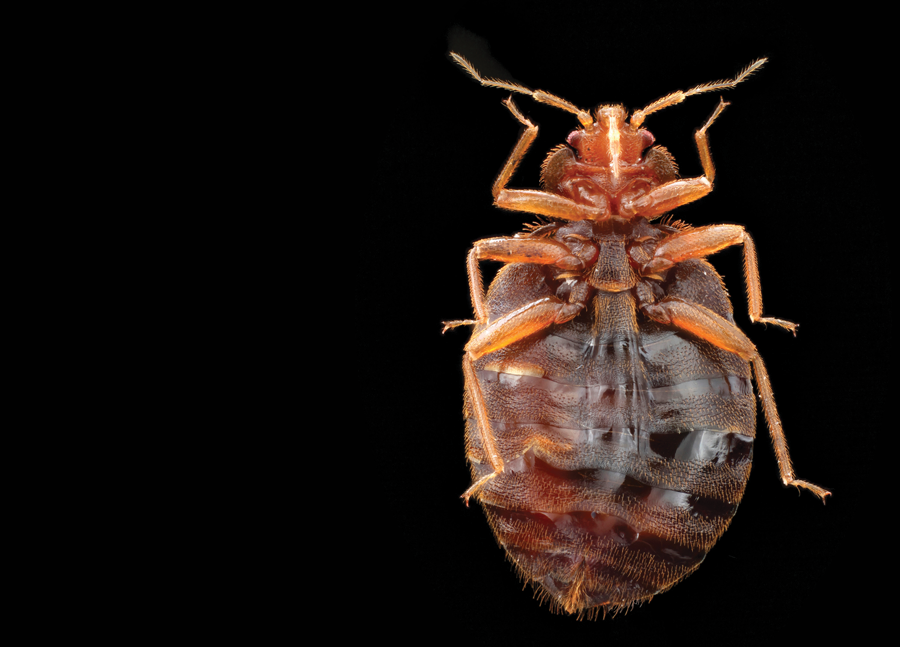
Editor’s Note: This article was reprinted with permission from Pinto & Associates.
The life span of an individual bed bug can vary considerably, from months to years. That variability depends primarily on temperature and other environmental conditions, the quality of food (blood) and its availability, and genetics. The average length of a typical bed bug’s life span from egg hatch to death in a laboratory environment, with ideal conditions, is six to 12 months.
But life in the real world is very different for a bed bug, and usually much shorter. Bed bugs living around someone’s bed face competition from other bed bugs, chemicals (cleaning and insecticides), crush risk during feeding, predators (spiders, ants, etc.) and other risk factors. Female bed bugs have higher mortality due to the risk from traumatic insemination (the male actually punctures her abdominal wall to plant sperm) during mating. If a bed bug survives all that…in the real world, temperatures fluctuate and rarely approach the ideals of lab conditions. Food, in the form of animal blood, doesn’t always appear on a regular basis in the real world either.
WHAT AFFECTS LIFE SPAN? Within a certain range, as the temperature goes up, bed bugs develop more quickly. The average development time from egg hatch to first egg laying is one to two months. At 80°F (27°C), egg to egg development time is about one month; at 64°F (18°C), that same egg to egg development takes four months.
Bed bug activity and development stops completely at certain temperature extremes, although exactly what those extremes are is debated. Earlier laboratory work found that bed bugs became inactive at temps below 57°F (14°C). Other studies though found still active bed bugs at temperatures as low as 44°F (6.6°C). Temperatures of approximately 97°F (36°C) seems to be the upper point at which bed bugs cease activity.
While temperature is a very important variable affecting bed bug life span, humidity seems to have little impact on the growth and development of bed bugs except at the extremes. Very low humidity increases desiccation and very high humidity can mean the growth of fungi.
FOOD AVAILABILITY. A bed bug normally feeds two to three times a week, and a blood meal is necessary for egg laying. But, a blood meal can be difficult to find at times, say when an apartment becomes vacant or a wilderness cabin is unused over the winter. Not to worry, bed bugs seem to have adapted to starvation and while egg laying may be put on hold, bed bugs can survive for surprisingly long periods without blood. Adults and late instar nymphs survive significantly longer than early instar nymphs, more than a year under certain conditions. Some experts have said that newly hatched nymphs will die within a few days of emerging from the egg if they do not locate a blood meal. Others say the young nymphs can survive for months.
Here’s where temperature comes into play again; temperature makes a difference in survival time in the absence of food. Starved bed bugs survived five to 10 times longer at 50°F (10°C) than at 80°F (27°C). This was true for all stages of the bug.
Recent studies suggest that bed bug development times also can vary with different bed bug populations. When three strains of bed bugs were compared, the time from egg to adult ranged from 35 to 40 days. One population of bed bugs that was highly resistant to pyrethroid insecticides developed significantly faster than the others.
WHAT DOES IT MEAN? You may need to rethink your criteria for declaring an account “bed bug-free.” Residual bed bug populations can remain alive in protected harborages for months after treatment, or while furniture is in storage, or during an extended period while rooms or structures are unoccupied. Vacating an infested room, or even an entire apartment so the bed bugs can “die out,” is not a feasible strategy for pest management professionals. Bugs won’t die any time soon and are apt to migrate to a new location where they can find new hosts.
Industry practice seems to be to wait seven to 10 days after bed bug treatment, than evaluate the success of the treatment. This doesn’t take into consideration temperatures at the account. Bed bug eggs at cool temperatures can take up to 21 days to hatch, long after you’ve declared the account bed bug-free.
It’s easy to understand why bed bug problems generally peak in the summer months, being greatest from July through September. Bed bugs develop faster at higher temperatures, and they are also more active and more noticeable. Even in accounts with air conditioning, the average indoor temperature is warmer in summer than in winter.
The authors are well-known industry consultants and co-owners of Pinto & Associates.
WANT MORE?
Enter your email to receive our newsletters.

Explore the March 2018 Issue
Check out more from this issue and find your next story to read.
Latest from Pest Control Technology
- The Clendenin Anthony Partnership Adds Welch to M&A Group
- Three Ways to Control Mosquitoes
- Mapping Termite Movement
- Indiana PCO Wins Cicada Bobblehead
- Typhoon 3 Sprayer
- A&C Pest Management Wins Best of Long Island Award
- Certus Promotes Rezk to Chief Marketing Officer
- Forty-Seven Percent of PCOs Increased Mental Health Care Benefits, Poll Finds






